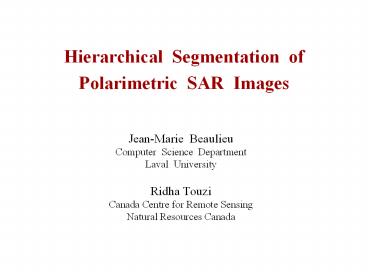Hierarchical%20Segmentation%20of%20Polarimetric%20SAR%20Images - PowerPoint PPT Presentation
Title:
Hierarchical%20Segmentation%20of%20Polarimetric%20SAR%20Images
Description:
Hierarchical Segmentation of Polarimetric SAR Images Jean-Marie Beaulieu Computer Science Department Laval University Ridha Touzi Canada Centre for Remote Sensing – PowerPoint PPT presentation
Number of Views:142
Avg rating:3.0/5.0
Title: Hierarchical%20Segmentation%20of%20Polarimetric%20SAR%20Images
1
Hierarchical Segmentation of Polarimetric SAR
Images
- Jean-Marie Beaulieu
- Computer Science Department
- Laval University
- Ridha Touzi
- Canada Centre for Remote Sensing
- Natural Resources Canada
2
Hierarchical Segmentation of Polarimetric SAR
Images
- Hierarchical Image Segmentation
- As a maximum likelihood estimation problem
- Segmentation of polarimetric images
- Segment sizes shape constraints
- Results
3
Image Segmentation is the division of the image
plane into regions
Two basic questions 1- What kind of regions do
we want ? 2- How can we obtain them ?
- Homogeneous regions
- Segment similarity
- Algorithm design
4
HIERARCHICAL SEGMENTATION BY STEP-WISE
OPTIMISATION
A hierarchical segmentation begins with an
initial partition P0 (with N segments) and then
sequentially merges these segments.
level n1
level n
level n-1
Segment tree
5
(No Transcript)
6
Sequence of segment merges.
7
SEGMENTATION AS MAXIMUM LIKELIHOOD ESTIMATION
1) need a partition of the image
2) need statistical parameters
3) need an image probability model
xi are conditionally independent
8
Given an image
the likelihood of
is
The segmentation problem is to find the partition
that maximizes the likelihood.Global search
too many possible partitions. is derived
from statistics calculated over a segment s.
9
The maximum likelihood increases with the number
of segments
number of segments
Can't find the optimum partition with k segments,
PkToo many, except for P1 and Pnxn.
Hierarchical segmentation ? get Pk from Pk1
by merging 2 segments.
10
- Stepwise optimization
- examine each adjacent segment pair
- merge the pair that minimizes the criterion
11
Merging criterion merge the 2 segments
producing the smallest decrease of the maximum
likelihood (stepwise optimization)
number of segments
Sub-optimum within hierarchical merging
framework.
12
Log likelihood form
Summation inside region
Criterion ? cost of merging 2 segments
minimize
13
POLARIMETRIC SAR IMAGE
Multi-channel image 3 complex elements
each element has a zero mean circular gaussian
distribution
Complex gaussian pdf (? is the covariance
matrix)
x is the complex conjugate transpose of x
14
The best maximum likelihood estimate of ? is
the covariance calculated over the region
(segment)
ns is the number of pixels in segment s
15
LML for a region s is
constant term for the whole image
16
The variation produced by merging 2 segments is
Hierarchical segmentation at each iteration,
merge the 2 segments that minimize the stepwise
criterion Ci,j
17
SEGMENTATION BY HYPOTHESIS TESTING
Test the similarity of segment covariances Ci
Cj C - merge segment with same covariance
Use the difference of determinant logarithms as a
test statistic
With the scaling factor K, the statistic is
approximately distributed as a chi-squared
variable with 6 degrees of freedom as nsi and
nsj become large.
18
Segmentation by hypothesis testing
Two hypothesisH0 segments are similarH1
segments are different
Distributions of the statistic d under H0 and H1
Two types of errorsType I not merging similar
segmentsType II merging different segments
19
? Prob( Type I errors )? Prob( Type II
errors )
Select the threshold to minimise ? or ?, but not
both simultaneously
20
In hierarchical segmentation, type II errors
(merging different segments) can not be
corrected,while type I errors can be corrected
later on.
The distribution of H1 and ? are unknown.Reduce
? by increasing ?.
21
Sequential testing? will be reduced as segment
sizes increase. ?12 ? minimum( ?1, ?2,
)?12 ? maximum( ?1, ?2, )
22
Stepwise criterionFind and merge the segment
pair (i, j) that minimizes Vi,j ( 1 - ? ).
Vi,j Prob( d ? di,j H0 ) ( 1 - ? ).
23
Amplitude values
hh
hv
vv
hh / hv / vv
80 pixels / cell
24
Correlation module (0 1)
hh vv
hh hv
vv hv
hh vv/ hh hv/ vv hv
25
Correlation phase (-180o 180o)
hh vv
hh hv
vv hv
hh vv/ hh hv/ vv hv
26
Amplitude image
27
1000 segments
28
500 segments
29
200 segments
30
100 segments
31
Amplitude image
5 pixels / cell
32
CRITERION FOR SMALL SEGMENTS
The determinant C is null for small segments
Reduce covariance matrix model for small segments
33
Gradual transition between models
34
SEGMENT SHAPE CRITERIA
High speckle noise ? first merges produce ill
formed segments
- Bonding box perimeter Cp
- Bonding box area Ca
- Contour length Cl
New criteria
35
Bonding box perimeter
36
Bonding box area
37
Contour length
38
1000 segments low resolution
39
1000 segments
40
500 segments
41
200 segments
42
100 segments
43
CONCLUSION
- Hierarchical segmentation produces good results
- Criterion should be adapted to the application
- Good polarimetic criterion
- The first merges should be done correctly































